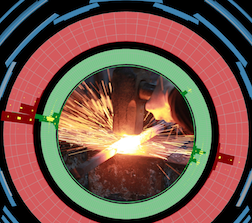Speaker
Description
Realistic neutrino mass models often predict the existence of electroweak- and TeV-scale heavy neutrinos that couple to Standard Model particle via mixing with left-handed neutrinos. However, owing to the large differences between the neutrino mass scales investigated and QED/QCD radiation scales typical of hadron colliders, recent calculations have been plagued with soft and collinear divergences, leading to erroneous predictions for the LHC and beyond.
A self-consistent treatment of heavy neutrino production mechanisms free of such divergences is presented. This includes: gluon fusion (GF) matched with 1 extra jet, charged and neutral current Drell-Yan (DY), DY + n-jets, and vector boson (VBF) fusion. Associated FeynRules/NLOCT and MG5_amc@NLO model files are publicly available.
At 14 TeV, we find that the LO GF rate is small and comparable to the NLO Charged Current DY+1j rate; at a future 100 TeV collider, GF dominates for neutrino masses up to 1.5 TeV, after which VBF takes lead.
Based on Degrande, et al: http://arxiv.org/abs/1602.06957
Summary
Realistic neutrino mass models often predict the existence of electroweak- and TeV-scale heavy neutrinos that couple to Standard Model particle via mixing with left-handed neutrinos. However, owing to the large differences between the neutrino mass scales investigated and QED/QCD radiation scales typical of hadron colliders, recent calculations have been plagued with soft and collinear divergences, leading to erroneous predictions for the LHC and beyond.
A self-consistent treatment of heavy neutrino production mechanisms free of such divergences is presented. This includes: gluon fusion (GF) matched with 1 extra jet, charged and neutral current Drell-Yan (DY), DY + n-jets, and vector boson (VBF) fusion. Associated FeynRules/NLOCT and MG5_amc@NLO model files are publicly available.
At 14 TeV, we find that the LO GF rate is small and comparable to the NLO Charged Current DY+1j rate; at a future 100 TeV collider, GF dominates for neutrino masses up to 1.5 TeV, after which VBF takes lead.
Based on Degrande, et al: http://arxiv.org/abs/1602.06957
